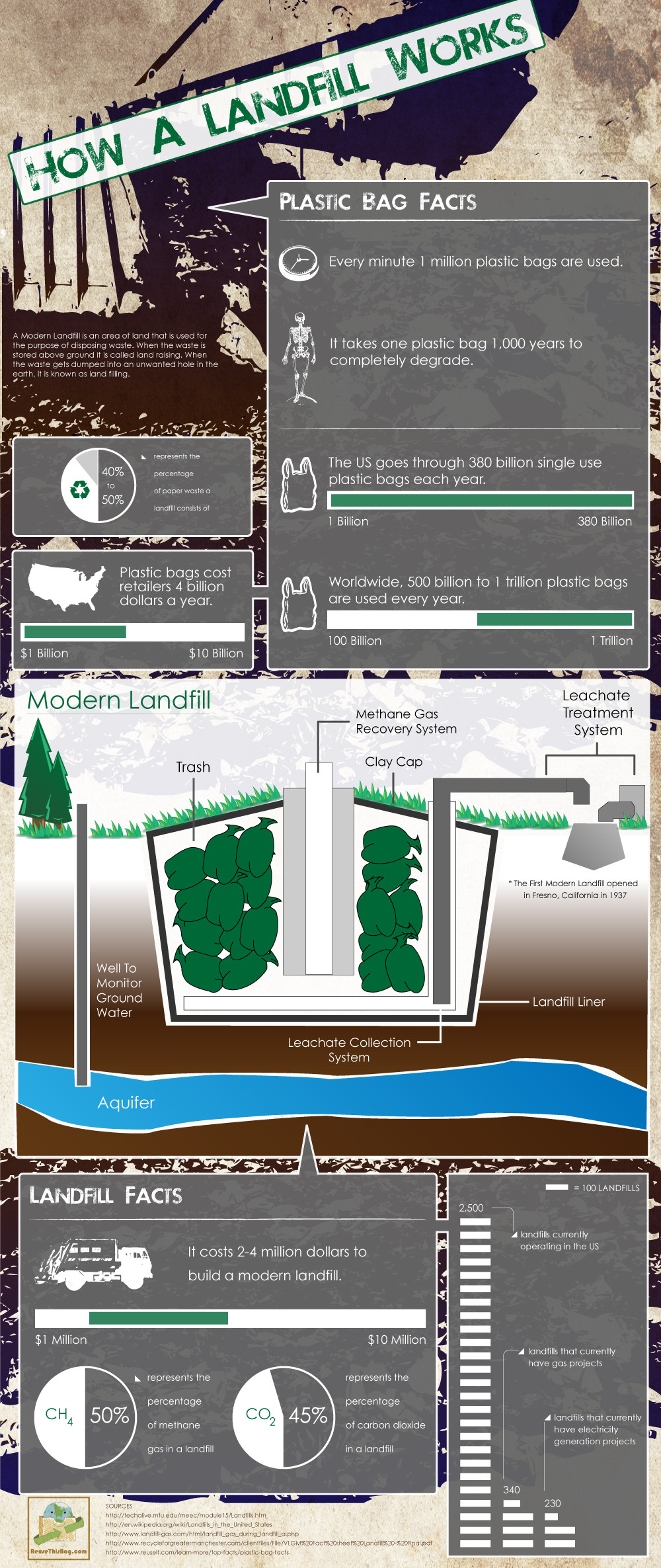Fair Use Statement
Information is power. Please share our content for editorial or discussion purposes. All we ask is that you link back to this page and give proper credit to our author.
Americans generate approximately 4.6 pounds of trash each day per person, which is 251 million tons. What happens to this trash? Much of the waste we produce ends up in a landfill in our communities across the country. By recycling and reusing as much of our refuse as possible, we all can do our part to reduce the amount of materials resulting in landfills, which number approximately 2,500 in the US today.
The infographic below provides information about how a landfill works and is created.
Landfill Statistics
According to recent statistics, landfills are filled wil up to 40-50% paper waste products. Also, much of what is in a modern landfill is plastic bags. It is estimated the US uses 380 single use plastic bags per year, and there are as many as 1 trillion used annually across the globe. By recycling and reusing our waste materials, we can eliminate much of the paper and plastic waste that goes into landfills. This is wise because it takes as long as 1,000 years for a single plastic bag to degrade.
How the Landfill in Your Community Works
Most communities in the United States spend between $2 million and $4 million to create a landfill, which is a carefully designed structure that is built into or on top of the ground where garbage is isolated from the environment (air, rain and groundwater). This isolation is done by using a bottom liner and covering of soil each day. A sanitary landfill will use a liner made of clay to isolate garbage from the environment. A municipal solid waste landfill uses a plastic liner to isolate the trash from the surrounding environment.
The purpose of the landfill is to bury garbage in a way that isolates it from groundwater. The refuse is kept dry and does not make contact with the air. Under such conditions, the trash does not decompose quickly. A landfill is different from a compost pile, where the idea is to bury garbage in a way so that it decomposes rapidly.
The major parts of a modern landfill are:
- Linear system: The linear system creates a barrier between the trash and the underlying soil and groundwater. Most landfill builders use a liner made of clay and a synthetic material. Clay is compacted to make it more impermeable. A plastic liner is put over the clay, with a drainage layer installed above the liner.
- Drainage and liquid management: The landfill must have a system to collect liquid from inside the landfill; this is called leachate. A pipe is put on top of the liner to allow for drainage and collection of rainwater.
- Landfill gas: Waste breaks down over time, and gas byproducts are produced. These gases are mainly methane and carbon dioxide. Carbon dioxide is most likely to exit the landfill with liquids. But methane is not as soluble in water and is usually a gas. This gas is captured at the landfill with a gas collection well. The gas is burned and also can be used as renewable energy in some communities. Methane gas is approximately 50% of the gas created by a landfill, while 45% is carbon dioxide.
- Rainfall collection: Stormwater runoff must be collected and stored in a pond. Soil particles settle from the water before it is disposed of in a local stream.
- Groundwater monitoring: This is an essential part of operating a landfill. A monitoring well is drilled and regularly checked to ensure groundwater is not being contaminated.
- Working face: This is where garbage is put by trucks and compacted. Every day, new trash is covered with soil.
- Final cap: When a landfill is full, it is topped with a cover and monitored for 30 years. The cap usually is a plastic liner and is then topped with 24 inches of soil.
Building a Landfill
For a landfill to be constructed in your city or town, operators must follow certain regulations. In the US, there are restrictions where a landfill can be situated and how it can operate. The process starts with a person or entity proposing the landfill to the local government.
In the US, disposing of trash is a responsibility of the local government. Before the community can construct the landfill, it is necessary for an environmental impact study to be performed. This study includes these parts:
- The area of land that is proposed for the landfill
- The makeup of the soil and bedrock in the area
- How surface water flows over the proposed site
- What the impact will be of the landfill on the environment and wildlife
- The value of the site in terms in archaeological or historical terms
After the study is completed, the entity must obtain permits and money needs to be raised from bonds to pay for an operate the landfill.
Conclusion
Modern landfills are an essential part of responsibly disposing of refuse. But all of us can help to reduce the need for landfill space by recycling and reusing as much of our trash as we can every day.
References
- Landfill engineering. (n.d.). Retrieved from http://site.republicservices.com/corporate/environmenteducation/landfill-engineering.aspx
- How a Landfill Works. (n.d.). Retrieved from https://science.howstuffworks.com/environmental/green-science/landfill.htm





